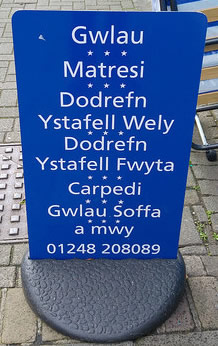
The other day I noticed the word gwlau on a sign outside a furniture shop. It’s a Welsh word I hadn’t seen or heard before, but from the context I worked out that it meant ‘beds’. The sign also included the words gwlau soffa (sofa beds). As I hadn’t come across this plural form of gwely [ˈɡwɛlɨ/ˈɡweːli] (bed) before, I wondered if it was a mistake.
According to Geiriadur yr Academi and Geiriadur Prifysgol Cymru, the plural forms of gwely are gwelyau or gwlâu, so the words on the sign weren’t wrong, but were just missing a to bach (circumflex) on the a.
Gwely comes from the Proto-Celtic *uɸo-legyom from *legh (to lie down), from the Proto-Indo-European *upo (under, below) & *legʰ- (to lie (down)), and is cognate with the Cornish guely and the Breton gwele. *legʰ- is the root of the Irish luigh, the Manx lhie, and the Scottish Gaelic laigh (to lie (down)); and also the Italian letto and French lit (bed), via the Latin lectus (bed); the English lair, the German Lager (store, camp), and the Swedish läger (camp), as well as other words [source].
In my limited and superficial exposure to Welsh I read (probably in Teach Yourself Welsh) that the rules for forming the plural of a Welsh noun are complicated. However, on looking at numerous examples I wasn’t able to discern any rules at all. One just has to learn each one as a special case. Are there, in fact, any rules that allow you to guess what the plural might be of a noun you’ve just met for the first time?
There are some patterns: http://www.forumwales.com/fwforum/viewtopic.php?t=577 – and probably some more.